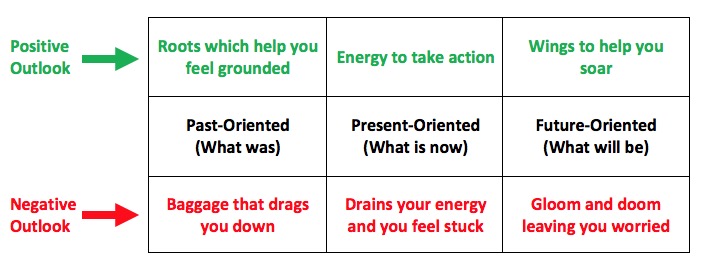Your time-orientation can create blindspots, cause stress and lead to team conflicts. Recognizing where you spend your time can give you options to be more effective.
Most of my CEO clients tell me that TIME is their scarcest resource. Given that time is something you can never get back, let’s explore your relationship with time.
The past is history, the future is a mystery, the present is a gift!
I notice that CEOs seem to have a preferred time-orientation. For instance, some are past-oriented, others can be future-oriented, and some are present-oriented. In reality, at any given moment, we are focused on the past, present or future. And as we navigate these different time periods, we can do so with a positive or negative view.

Each time-orientation can be valuable, and each could also turn into a liability – it all depends on the context. When viewed with a positive outlook, the past can give you roots and help you feel grounded, whereas the future can give you wings and help you soar to new destinations and overcome challenges. The present can give you energy to take action.
On the other hand, when viewed with a negative outlook, the past can be baggage that weighs you down, while the future can appear bleak and leave you worried. The present could also drain your energy and leave you unable to act.
Time-orientation can influence you

Taken a step further, a positive focus on the past can mire you in nostalgia, thinking about the good old days, while the future-focused positive can transport us into a fantasy for a bright future. And the present-focused positive can create hopefulness.
By contrast, the past-focused negative can leave us hosting our own pity party, regretting past decisions. The future-focused negative can lead to engaging in what psychologists call catastrophizing about the future, or constantly thinking of all the things that can go wrong. The present-focused negative can instill fearfulness.

The key is to recognize which orientation you are experiencing and how that is impacting your view of the world.
The Role of Time-Orientation in your Business
Time-orientation is very much at play within different functions in a business. Some functions are naturally focused on the present while others are focused on the past or the future.
For instance, the strategy team is looking at the future, applying a positive lens to identify opportunities, whereas the risk management team is looking at the future and applying a negative lens to identify risks. Similarly, the audit team is looking at the past to identify problem areas and weaknesses, whereas the financial reporting team is looking at the past to identify bright spots in business performance. The sales teams are focused on producing results in the present, while the IT security team is looking at any immediate threats that can stop the business in its tracks.
Time-orientation in the context of business roles

Implications for CEOs
Too Much of a Single Time-Orientation can Create Blindspots.
While large corporations typically have the resources and structures to dedicate teams to exclusively operate in different time horizons, mid-market companies may not have the same luxury. Mid-market CEOs need to intentionally shift their time horizons to ensure there are no blindspots. This is easier said than done as the CEO’s past experience may make them skilled at managing certain time horizons and leave them handicapped in other areas.
For instance, an optimistic CEO with a sales background might be excellent at being present-oriented with a positive outlook but may struggle to learn from past mistakes or forecast future risks. On the other hand, a pessimistic CEO with a risk management background might be excellent at being future-oriented and foreseeing potential risks but may struggle with making quick immediate decisions with limited information.
A Primary Driver of Stress is Rumination
Many CEOs faces high levels of stress, which can show up as irritability, anxiety, poor sleep and fatigue. One of the primary factors of chronic stress is rumination about the past and the future.
Rumination is the mental process of thinking over and over about something, which happened either in the past or could happen in the future, and attaching negative emotion to it. Ruminations about the future are associated with “what if this happens?’” or “what if that happens?” Ruminations about the past replay, over and over, some awful experience you had and usually end with, “if only I had . . .” or “I should have done . . .”
Nick Petrie, Author of Work Without Stress
Many Conflicts are Time-Zone Clashes
A common source of conflict on teams comes when individuals hold different time perspectives. For example, your CFO is worried about increasing expenses which might lead to missing annual profit numbers, whereas your VP of Sales is keen on making investments to hit the monthly targets. Your head of strategy wants to pivot the business to capture trends unfolding in the next 2-3 years and your head of operations wants to maintain the status quo, as her goals may be compromised if the business pivots. One team member is focused solely on the upside opportunity while another is focused on the downside risks.
The failure to recognize and manage this common challenge can lead to wasted time and effort and can be a drag on team morale.
CEOs of small and mid-size companies have to be agile and highly skilled at managing time-orientations for themselves and their teams.

